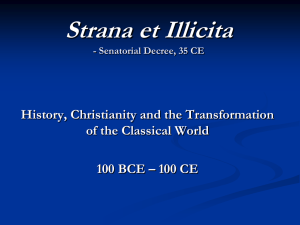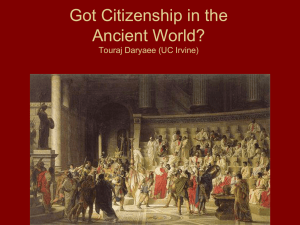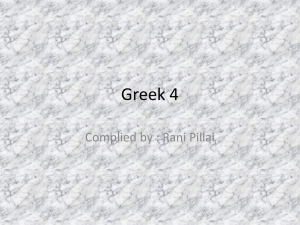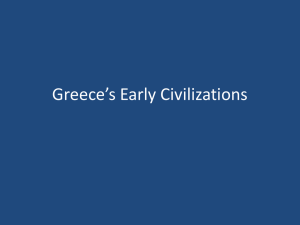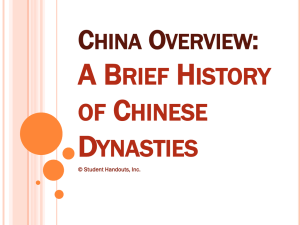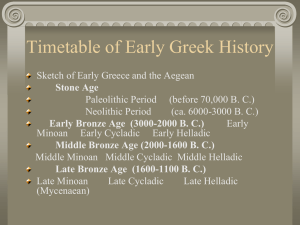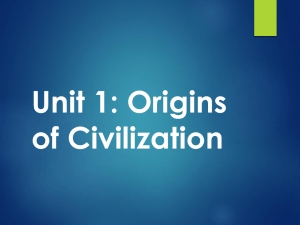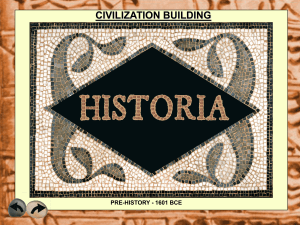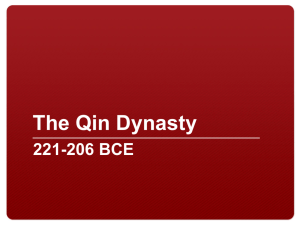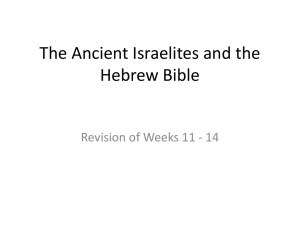Thalassocracy and Minoan Crete
advertisement
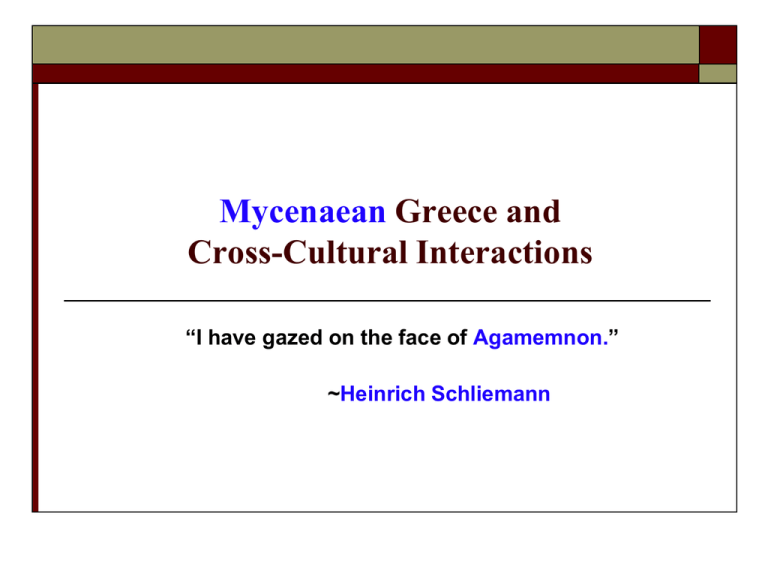
Mycenaean Greece and Cross-Cultural Interactions “I have gazed on the face of Agamemnon.” ~Heinrich Schliemann Dating Scheme after J.-B. Bury (following Evans) Early Minoan I II III Middle Minoan I II III Late Minoan IA IB (mainland takeover?) II IIIA IIIB IIIC Early Helladic 2800-2500 BCE 2500-2200 BCE 2200-2000 BCE I II (arrival of Greeks?) III 2000-1900 BCE 1900-1700 BCE 1700-1550 BCE Middle Helladic I II III 1550-1500 BCE 1500-1450 BCE 1450-1400 BCE 1400-1300 BCE 1300-1200 BCE 1200-1050 BCE Late Helladic IA IB II IIIA IIIB IIIC Thera and Crete Thera (Santorini)-Satellite Image Minoans and Mycenaeans Thera explosion ca. 1600 BCE Trading empora: Minoan pottery replaced by Mycenaean by ca. 1450 BCE Struggle for Mediterranean hegemony between Minoans and Mycenaeans, ca. 1600-1400 BCE Mycenaean takeover of Crete ca. 1450 BCE Final destruction of Knossos ca. 1380 BCE (Linear B) Flotilla Mural from Thera Excursus: Heinrich Schliemann Excavator of Mycenaean civilization Autodidact; early fascination with Homeric poems “Outsider” to academic establishment W. Doerpfeld and credibility Entrepreneur and Treasure Hunter Modern Assessments Heinrich Schliemann Mycenaean Argolid Mycenaean Death Mask Mycenaean Trading Contacts from Minoan Crete Height of Mycenaean Greece: ca. 1400-1200 BCE (LH IIIIIB) Cultural Influences (palace architecture, frescoes, seal stones, fine gold work) Trading Emporia in the Near East and West (Taranto) General Characteristics Centralized Administration (king or wanax); Palace as Redistributive Economy Highly Organized Bureaucracy (Linear B Palace Inventories) Complex Social Structure Royal Family (wanax: military, legislative, judicial, religious functions) Nobility (priests and scribes) Merchants (?), Agricultural Workers, and Craftsmen Slaves Mycenae: Shaft Graves (circles A and B): ca. 1650-1550 BCE; tholos (“beehive”) tombs: ca. 1500 BCE; “Treasury of Atreus”: ca. 1300 BCE Royal Grave Circle A circa 1600 BCE Entrance to “Treasury of Atreus” Cross-Section of Tholos Interior of “Treasury of Atreus” Corbeled Arch (ca. 1300-1250 BCE) Mycenaeans and Minoans Significant Differences Mycenaean Palaces are closed; strongly fortified Mycenaean art: war motifs predominate “Warrior Vase” circa 1200 BCE Vapheio Cup (ca. 1400-1300 BCE) Citadel of Mycenae Aerial View of Citadel at Mycenae Lioness Gate at Mycenae Writing: Linear B Script Monopoly of the Elites Linear B script virtually unchanged destruction at Knossos, ca. 1380 BCE (following Biers) destruction at Pylos, ca. 1250 BCE Linear B Tablets End of Mycenaean Civilization and Trojan War Back to Lecture One Thirteenth and twelfth-century Mediterranean BCE context: Turmoil in the Mediterranean basin and the Near East (“Sea Peoples”). ca. 1200 BCE--Egypt weakened; Hittite empire collapses; destruction at Mycenaean centers (Tiryns, Mycenae, Pylos, Thebes; ca. 1150 BCE: final destruction at Mycenae) Greece--lines of trade disrupted (e.g. contact with Cyprus, a source of copper, is broken) Fortifications strengthened at Mycenae; secret passageway to underground cistern Secret passageways to water sources at Athens and Tiryns Isthmian Wall Archaeological Evidence of Troy VII A--a last gasp Mycenaean expedition? Collapse of Mycenaean Civilization Explanations: Intruder, Environmental, Class Conflict Tradition: return of Heracleidae and the Dorian invasion (Sparta) Problem: tradition dates invasion to ca. 1100 BCE; archaeological evidence indicates a date closer to 1200 BCE Identifying the Dorians? Invaders or Subject Population within Mycenaean society? Alternatives: climatic--famine leads to internal social revolutions; inter-city wars Trojan War; Nostoi; Egyptian records and Achaeans (Sea Peoples)
